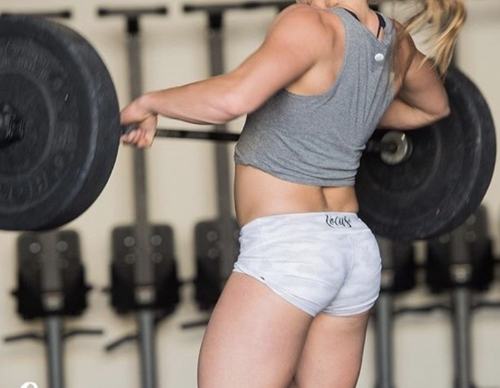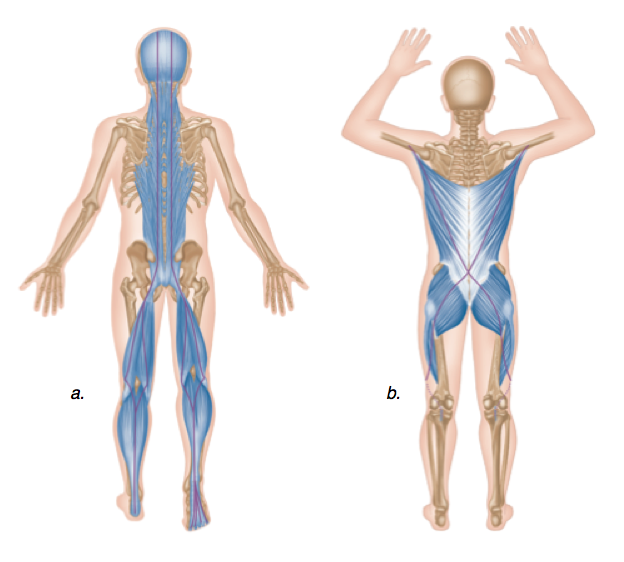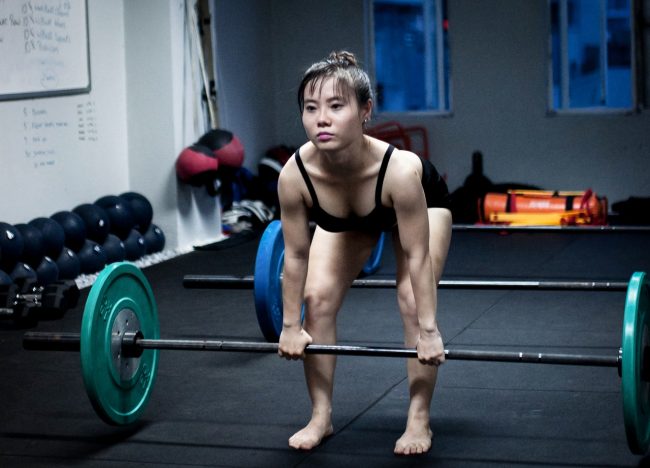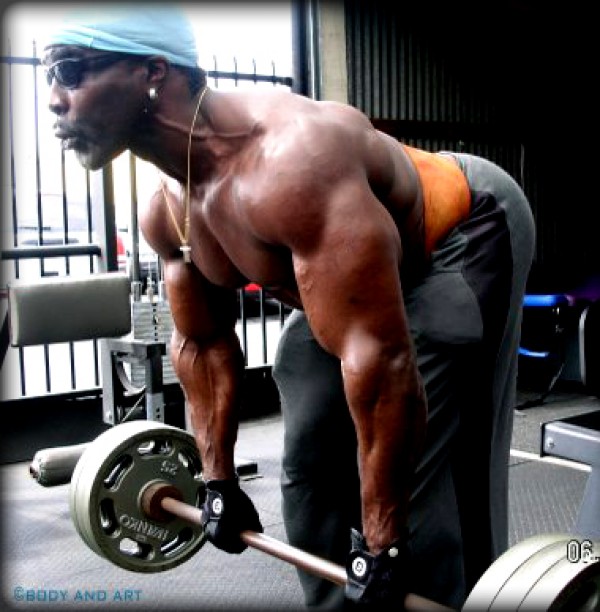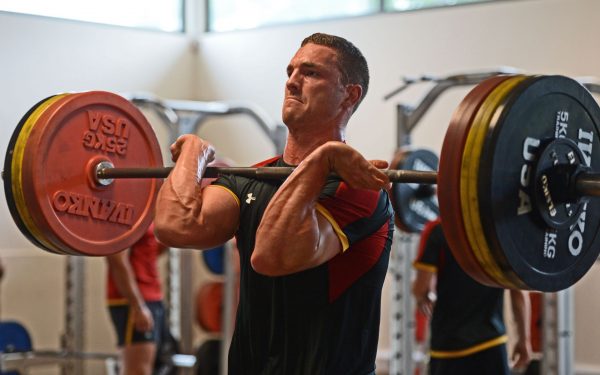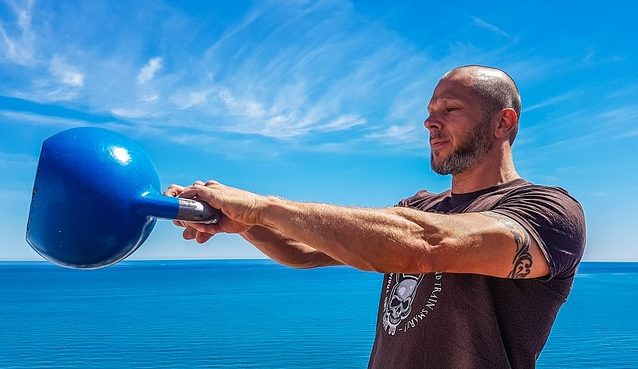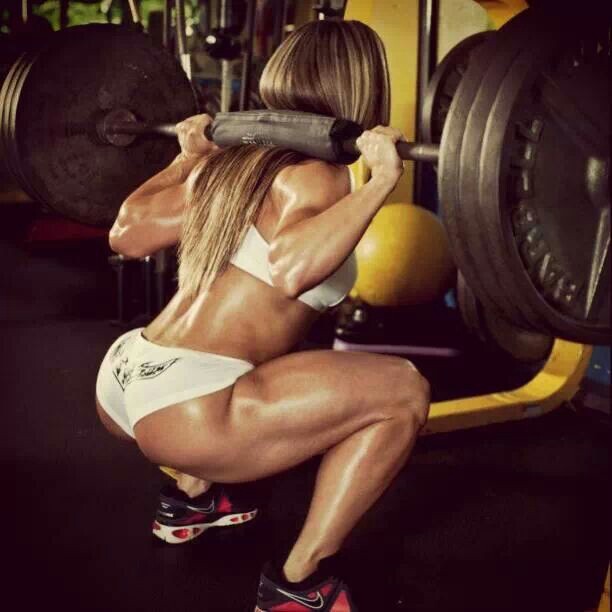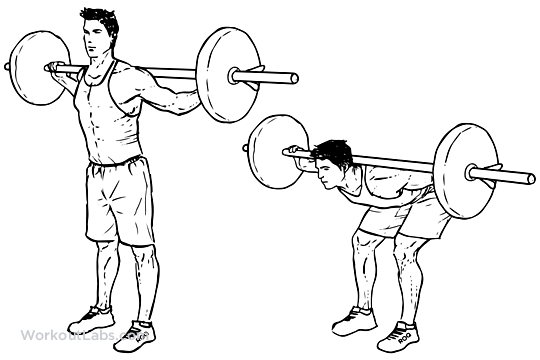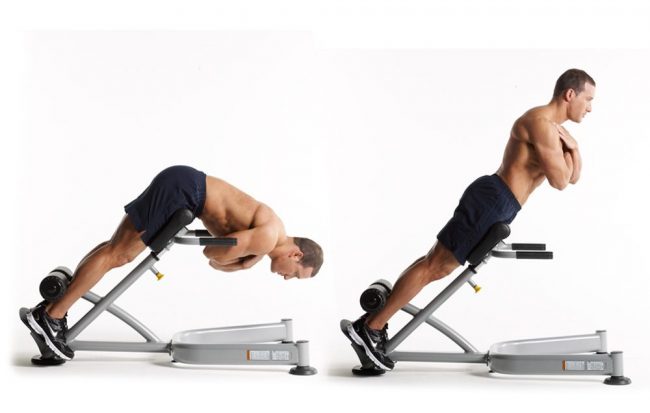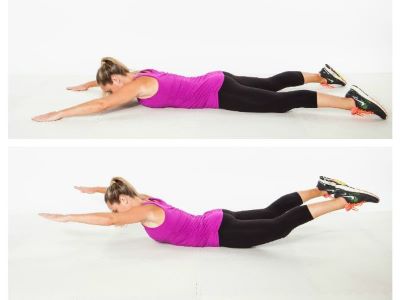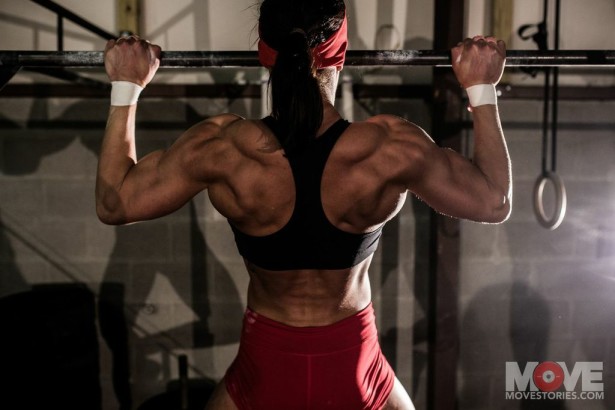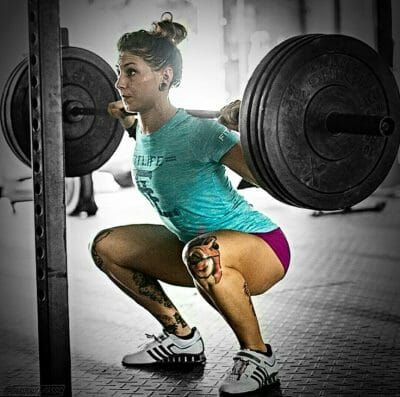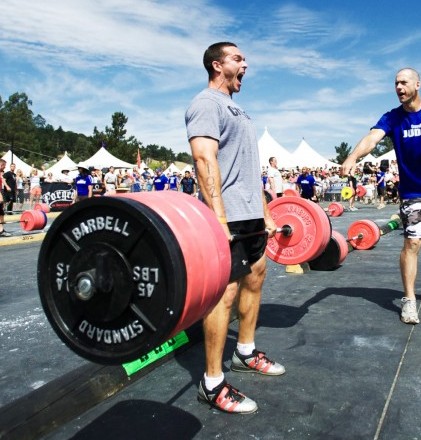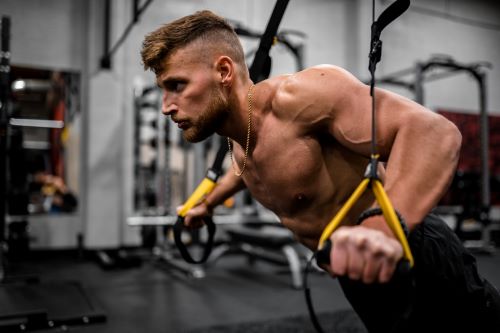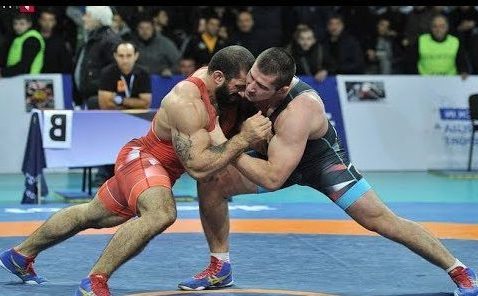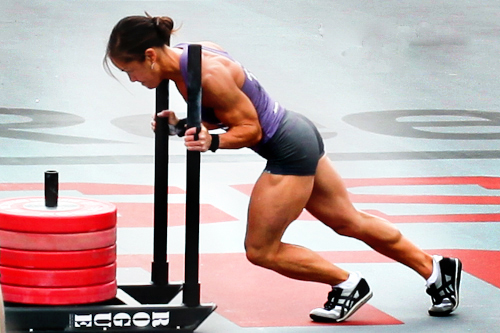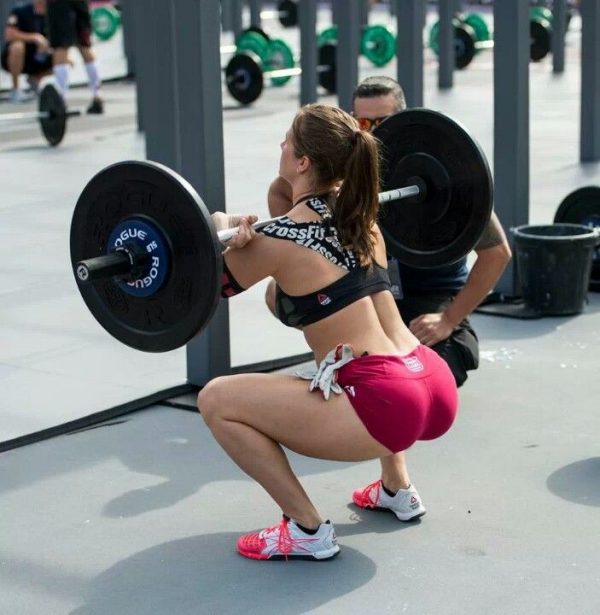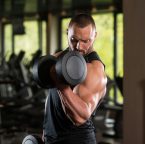It’s time to talk about the posterior chain.
The posterior chain can often be forgotten since most people only focus on what they can see in the mirror which is usually abs, biceps, chest, and quads.
The posterior chain is just as important, though and some could say even more important.
In this article, we are going to tell you why you need a solid posterior chain and also give you the best posterior chain exercises.
What is the posterior chain?
Simply put, the posterior chain is the muscles on the backside of the body. The hamstrings, glutes, erector spinea, lat, traps, rhomboids, and even the calves.
While butt training is all the rage these days the rest of those posterior chain muscles often go under-trained or completely forgotten about.
Why you need a strong posterior chain
These days, most of us spend a lot of our day in a seated position in front of the computer or television. This causes your posterior muscles, like the glutes and hamstring muscles to become lengthed and weak. This can lead to muscle imbalances, a hunched/rounded shoulder appearance as well as an anterior pelvic tilt and lower back pain. Not good!
This is why you need to keep your posterior chain muscles strong to fight these imbalances and keep your posture in check.
Not only that, if you are an athlete, the posterior chain is the powerhouse of the body. Think about how a running back, rugby player or a wrestler needs to have strong hips and glutes to push and drive people on the field or mat. An athlete with a weak posterior chain will not perform as well as they should, it is as simple as that.
Bottom line…
A strong posterior chain will help with your athletic power, posture, and lower back pain and it will give you a nice-looking rear end to boot. Now let’s get on to the exercises.
The Best Posterior Chain Exercises
These are the best posterior chain exercises
#1 The Suicide Row
The Suicide Row is a beast of posterior chain exercise as it combines hip extension with thoracic extension to hit virtually the entire posterior chain.
This exercise is done with a GHD machine or a horizontal back extension machine, if your gym doesn’t have one of those rigging up some sort of alternative is possible but will be tricky.
You will want the GHD machine set at hip height and you can use any grip you like on a barbell for the rows or even do the rows with dumbbells which is what I prefer.
Make sure to squeeze the glutes while performing the hinge motion and you should only go up until you are parallel to the floor and maintain a flat spine throughout.
Lee Boyce is a great fitness writer and one of the top minds in fitness and bodybuilding, he wrote a nice article about the suicide row that you can check out right here. Above is also a video of him performing the movement so you can see exactly how it is done.
#2 The Romanian Deadlift
Deadlifts are the king of all weightlifting exercises as many of you know so for our second exercise we are going to go with a variation called the Romanian deadlift.
The Romanian deadlift is done with more stiff and straighter legs than a traditional deadlift and in the Romain deadlift you do not put the weight on the floor after each rep. This is more of an eccentric movement that stretches the hamstrings and glutes on the way down to really work them harder than you would in a conventional deadlift.
This exercise is my personal go-to when it comes to the posterior chain and hamstring exercises and is one that you will definitely feel the next day especially if it is your first time doing the exercise. Also if you are new to this exercise I would only do 1 set on the first day and work your way up to 2-3 sets from there. If you try to be a hero and do 2-3 sets your first time doing this exercise your hammies will likely be extremely sore, you have been warned.
If you still aren’t 100% sure how a Romanian deadlift is done check out this quick 2-minute video by Mark Rippletoe which shows you exactly how to do it.
How To Perform
To perform a Romanian deadlift, start by standing with your feet hip-width apart while holding a barbell in front of you with an overhand grip. Your hands should also be slightly wider than hip-width. Keep your knees bent slightly throughout the movement.
Hinge at your hips to lower the barbell, keeping it close to your body and your back straight. Lower the bar until you feel a stretch in your hamstrings, usually just past your knees. Reverse the movement by driving your hips forward to return to the starting position. Make sure to engage your glutes and hamstrings as you come up.
#3 Bent Over Rows
I know what you are thinking, bent-over rows are a back exercise. While bent-over rows are great for adding thickness and width to your lats they also work your entire posterior chain as well.
If you think about it your positioning when doing bent-over rows is about the same as it is when you are halfway down on a Romanian deadlift.
This move blasts your hamstrings, glutes and erector spinea from being bent over like that while rowing which also hits the lats and traps.
This is one of the best and most under-appreciated posterior chain exercises out there. Add this to your routine and work your entire back.
How To Perform
Grab a barbell with an overhand grip, hands positioned a bit wider than shoulder-width apart. Start by bending your knees slightly and hinging at the hips until your torso is at about a 45-degree angle to the floor. Keep your back straight and your core engaged.
Let the barbell hang down in front of you with your arms fully extended. Pull the bar towards your lower ribcage by squeezing your shoulder blades together. Once the bar touches your body, lower it back down to the starting position. Focus on keeping the movement controlled and really engage your back muscles as you lift.
#4 Glute Ham Raise
Next up, we have glute-ham raise. The easiest way to do this exercise is with a GHD machine. It may look like the suicide row without the barbell, but the movements are actually quite different if you watch both videos,
As you can probably guess from the name the glute-ham raise works the glutes and the hamstrings (it really hammers the hamstrings). It also hits the erector spinea as well.
It should be noted if you don’t have a fancy GHD machine like the example above you can still do this exercise, here is a good video on how to do just that. All you really need is something sturdy to secure your ankles under and you can do this exercise.
How To Perform
To start the glute ham raise, position yourself on a GHR machine with your feet secured under the footplate and your knees just behind the pad. Keep your torso upright and engage your core.
Begin the movement by lowering your upper body towards the ground in a controlled motion, hinging at the knees. When you reach the bottom, reverse the movement by driving your toes into the footplate and squeezing your glutes and hamstrings to bring your torso back to the starting position. Maintain a straight back and tight core throughout the exercise.
#5 Cleans
We love cleans. They build strength, power and explosiveness that every athlete needs. They are also great for your posterior chain.
Whether you are performing the hang clean or the power clean you will find out pretty quickly that it is a great whole-body workout that hammers the entire posterior chain, especially the muscles in your back.
The only problem with this exercise is that it can be difficult to do correctly if you have never done them before. Check out our article Power Cleans: The Ultimate Athlete Exercise for more information on this exercise, and talk to a trainer or coach to make sure you are doing this exercise right to get the most out of it and avoid injury.
How To Perform
Start with the barbell on the floor, positioned close to your shins. Stand with feet hip-width apart, and grip the bar wider than shoulder-width with an overhand grip. Your back should be straight, chest up, and eyes looking forward.
Bend your knees and hips to lower into the starting position. Explosively extend your hips and knees, pulling the bar off the ground. As the bar rises, quickly get under it by dropping into a slight squat and catching the bar on your shoulders. To finish, stand up fully with the bar resting on the front of your shoulders.
Lower the bar back to the ground safely to complete one rep. Remember to keep the movements quick and explosive, and always maintain good form.
#6 Barbell Hip Thrust
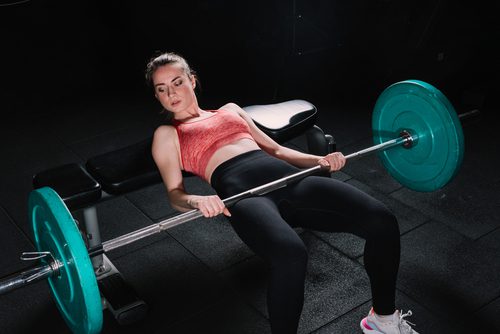
Hip thrusts are easily one of the best glute exercises out there. While they are the cousin to the glute bridge you use a larger range of motion with the hip thrust, and it is more traditionally done with a barbell across your waist for added resistance and a superior posterior.
This movement isn’t just for your glutes though, the hamstrings also get worked pretty hard as well. Make sure to hold this movement at the top for 2-5 seconds for an extra burn.
How To Perform
Begin by setting up a barbell with appropriate weight and sitting on the ground with the barbell just above your hips. Roll the bar over your hips and lean back against a bench so that your shoulder blades are on the edge of the bench.
Bend your knees and place your feet flat on the floor, hip-width apart. Drive through your heels, lifting your hips towards the ceiling by squeezing your glutes. As you reach full hip extension, execute a small hop by pushing your feet off the ground.
Land softly and immediately lower your hips back down to just above the ground to complete one rep. Keep your core engaged and focus on using your glutes and hips to perform the movement.
#7 Kettlebell Swings
Kettlebell swings are one of the best exercises out there and are still very underutilized by most athletes and just about everyone at the average gym.
This exercise is another great power builder for the hips that works the glutes, hamstrings and erector spinea.
When performing this bad boy hinge at the hips and explosively shoot your hips forward until full extension to make the kettlebell go up. The bell should not go higher than shoulder height. Let the bell fall back down between your legs and repeat.
Not only is this exercise good for working your posterior chain muscles and building power, but it can also be great cardio as well.
How To Perform
Start by standing with your feet shoulder-width apart and a kettlebell a few feet in front of you. Hinge at the hips and bend your knees slightly to grab the kettlebell handle with both hands, using an overhand grip. Keep your back flat and your core engaged.
Lift the kettlebell off the ground and start swinging it between your legs. To initiate the swing, thrust your hips forward and straighten your legs, propelling the kettlebell upwards. Aim to bring the kettlebell to shoulder height, keeping your arms straight.
As it descends, hinge at the hips again and let it swing back between your legs. The power should come from your hips and glutes, not your arms. Keep the motion fluid and controlled throughout the reps.
#8 Reverse Hyper
Next up on our list of the best posterior chain exercises, we have the reverse hyper. This movement hits the lower back, glutes and hamstrings.
If you think about it, doing a reverse hyper is basically a kettlebell swing but this time the legs move the weight and the upper body is stationary instead of vice versa. The reverse hyper is a lot easier on your lower back than the kettlebell swing is though.
This exercise, in particular, has been noted to help many people with back pain and bulging discs, no promises it will do that for you but those claims are out there.
You will likely need a reverse hyper machine for this exercise. It is possible to rig your own set up with a sturdy table but it’s not easy nor is it as effective.
How To Perform
To perform the Reverse Hyper exercise, you’ll need a reverse hyper machine or a similar setup. Position yourself on the machine so that your upper body is supported and your hips are at the edge of the pad. Secure your feet under the foot straps and let your legs hang down naturally.
Begin the exercise by engaging your glutes and lower back to lift your legs up until they are roughly parallel to the ground. Pause briefly at the top, then lower your legs back down in a controlled manner. The focus should be on squeezing your glutes at the top of the movement and keeping your back straight throughout.
#9 Squats
When many people think about squats they think about big quads but squats work a lot more than just the front portion of the legs. They also hammer your glutes, erector spinea, lats, traps and hamstrings. that is almost the entire posterior chain right there.
You don’t have to do back squats like in the image above either. Goblet squats, air squats and all other squat varieties will also work just fine.
How To Perform
Start by standing with your feet shoulder-width apart, toes slightly pointed outward. If you’re using a barbell, position it on your upper back, gripping it wider than shoulder-width apart. Keep your chest up and your core engaged.
Initiate the squat by pushing your hips back and bending your knees, lowering your body as if you’re sitting back into a chair. Aim to go as deep as your mobility allows, ideally until your thighs are parallel to the ground or lower.
Push through your heels to return to the starting position, fully extending your hips and knees. Keep your back straight and chest lifted throughout the movement.
#10 Sled Pushes
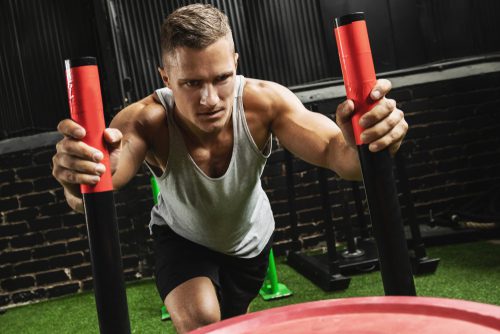
If you are lucky enough to have a dog sled at your gym then this is an exercise you should definitely be doing. Sled pushes will hit your glutes, hamstrings, calves and even the bottoms of your feet. Not only that but sled pushes are also some of the best cardio you can do, not a bad 1-2 punch.
If you don’t have a sled you could push your car up and down the driveway but make sure you have someone in the driver’s seat to hit the brakes when needed.
How To Perform
Load a sled with the appropriate amount of weight, ensuring the sled is on a surface that allows for smooth movement. Stand behind the sled, placing your hands on the handles or horizontal bars at about chest height. Your feet should be hip-width apart, and your body should form a straight line from head to heels.
Lean into the sled and begin to push off with your legs. Take powerful, deliberate steps, driving through your heels and extending your hips and knees with each step. Keep your back straight and your core engaged as you move the sled forward. The focus should be on maintaining a strong and stable posture while exerting force to push the sled.
#11 Good Mornings
Next up, we have good mornings. These can really hammer the hamstrings and erector spinea which makes them perfect to add to your posterior chain workout.
This exercise is a lot like the Romanian deadlift, but rather than holding the weight it is on your shoulders instead.
Having the weight on your shoulders does put a lot of strain on the lower back though, so if you have any back issues, this is an exercise you will definitely want to avoid.
How To Perform
Start by placing a barbell on your upper back, just like you would for a squat. Stand with your feet hip-width apart, keeping a slight bend in your knees. Your hands should grip the bar wider than shoulder-width, and your core should be engaged.
To initiate the movement, hinge at your hips and lower your torso towards the ground while keeping your back straight. Go as far as your hamstring flexibility allows, ideally until your torso is nearly parallel to the floor. Reverse the motion by pushing your hips forward to return to the starting position. Throughout the exercise, make sure to keep your back straight and core tight to protect your lower back.
#12 Seated Cable Row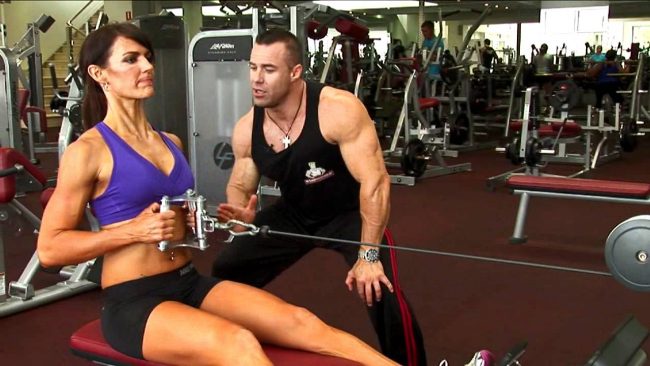
The seated cable row is one of my favorite back exercises but it doesn’t just hit the back, it also hits your hamstrings and glutes as well.
You can do this with a close grip handle or wide bar if you prefer, you can also use a band if you are training at home.
Pull the handle or band back to your lower chest and squeeze each rep. Also, make sure you get a good stretch in those hamstrings every time you lean forward to take another rep.
How To Perform
Sit down at a cable row machine with a V-handle or wide-grip handle attached. Plant your feet on the platform, knees slightly bent. Lean forward to grab the handle, then sit back so your torso is upright and your arms are fully extended. Engage your core and keep your back straight.
Initiate the row by pulling the handle towards your lower ribcage, squeezing your shoulder blades together as you pull. Once the handle touches your body, pause briefly, then extend your arms back to the starting position.
The focus should be on using your back muscles to perform the movement, not pulling with your arms. Keep your back straight and avoid using momentum or leaning back excessively.
#13 Back Extensions
For this bad boy, you can use a GHD machine or a machine made for extensions as pictured above. DO NOT use that cheesy back extension machine at the gym though, that piece of junk causes more problems than it fixes.
This exercise works the erectors, glutes and hamstrings.
Hook your feet in and lower yourself slowly to about 45 degrees, then return to the top, making sure not to overextend and arch your back at the top.
These are best done for high reps using just your body weight or weight that is on the lighter side held in your hands.
How To Perform
To do back extensions, position yourself on a back extension bench or Roman chair, hooking your heels under the leg anchor and aligning your hips with the edge of the pad. Start with your upper body angled down, torso in line with your legs, and hands either crossed on your chest or behind your head.
Begin the movement by lifting your upper body towards the ceiling, using your lower back muscles. Aim to bring your torso just past parallel to the ground, feeling a contraction in your lower back.
Lower yourself back down to the starting position in a controlled manner. Throughout the exercise, keep your back straight and focus on using your lower back muscles, not momentum, to lift your upper body.
Related: How To Get Round Glutes: Workout and Exercises
#14 Supermans
This one is probably the simplest of all the posterior chain exercises and it is an exercise you can do most anywhere.
Supermans are excellent for strengthening the lower back and engaging those glutes, and also helping correct rounded posture caused by excessive sitting which most people are guilty of.
Simply lie on the floor face down and simultaneously raise your arms and legs off the floor as high as you can and pretend like you are flying like Superman.
Hold this position for a few seconds, then go back down. Repeat this 10-15 times.
How To Perform
To perform the Superman exercise, start by lying face down on a mat with your arms extended in front of you and your legs straight. Keep your head in a neutral position by looking down at the mat.
Initiate the movement by lifting both your arms and legs off the ground as high as comfortably possible. The aim is to arch your back slightly, using your lower back, glutes, and shoulder muscles.
Hold the raised position for a few seconds, then lower your arms and legs back down to the starting position. Keep the movements controlled and focus on engaging the muscles in your back and glutes.
#15 Bird Dogs
Bird dogs are one of the best exercises out there for glute activation, core stability as well as your posture.
Why is it called the bird dog? My guess is because one arm goes up like a flying bird and the opposite leg goes up like a peeing dog. I’m not sure if that’s correct, but it works for me.
Anyway, be sure to watch the video above from our friend Eric Bach and read the description for this exercise. It may look simple enough but it is almost always done incorrectly. That is why we made sure to include a good video with this exercise, if done incorrectly it is basically useless. Take your time and do it right.
How To Perform
To perform the Bird Dog exercise, start on all fours with your hands directly under your shoulders and your knees under your hips. Keep your back flat and your core engaged.
Extend one arm out in front of you while simultaneously extending the opposite leg behind you. Aim to form a straight line from the tips of your fingers to the tips of your toes.
Hold this position for a few seconds, focusing on balance and stability. Return to the starting position and then repeat on the other side. Keep your movements controlled and your core tight throughout the exercise.
#16 Pull-Ups
Rounding out our list of the best posterior chain exercises, we have the good old fashion pull-up.
It’s a simple enough exercise: grab a bar and pull yourself up until your chin is above the bar, lower yourself back down and repeat. While the action is simple enough, it may be difficult for beginners. If you are having trouble doing multiple pull-ups or even getting your very first pull-up, check out our article on tips to make your pull-up easier.
Pull-ups work your entire back, including the lats, erectors, traps, levator scapulae and your rhomboids. You can also include the teres major, teres minor, and many other small muscles in the back you have never heard of, along with your biceps, abs, obliques, and shoulders.
With a list of muscles worked that long, you should definitely be sure to include pull-ups in your regular workout routine, not just for working the posterior chain.
How To Perform
To perform pull-ups, start by gripping a pull-up bar with your hands slightly wider than shoulder-width apart, palms facing away from you. Hang from the bar with your arms fully extended, feet off the ground, and your core engaged.
Initiate the pull-up by pulling your shoulder blades down and back, then continue to pull yourself up until your chin is above the bar. Lower yourself back down in a controlled manner until your arms are fully extended again. T
he focus should be on using your back and bicep muscles to lift your body, rather than swinging or using momentum. Keep your core tight and body straight throughout the exercise.
How to Program Posterior Chain Exercises
So here’s the deal: Weightlifting isn’t a one-size-fits-all game. Your routine will definitely depend on what you’re aiming for and what feels right for you.
Now, let’s talk about training your backside, also known as the posterior chain. It’s crucial for anyone lifting weights. It might be a bit challenging because we’re dealing with bigger muscles, but trust me, the rewards are totally worth it. A strong backside helps with pretty much everything you do in the gym.
Exercise Order: Do the exercises that require the most energy first, when you’re feeling fresh. So if you’re aiming for power, go for kettlebell swings or high pulls first. If it’s strength and muscle you’re after, then exercises like Romanian deadlifts or glute-ham raises should be your starting point.
Choosing the order of exercises on a strength-training day? Just use common sense. Maybe don’t stack two exercises that could strain your lower back, like bent-over rows and Romanian deadlifts, back-to-back.
Strength Sets & Reps: For building strength, you’ll generally want to lift heavier. Aim for a load that’s at least 80% of your one-rep max. Your sweet spot is somewhere between 10 to 25 total reps. You could divide these into different sets and rep counts based on your comfort and goals. For instance, you could do three sets of five, or five sets of two. It varies.
Muscle Sets & Reps: Now if you’re more about building muscle, it’s all about volume and time under tension. Stick to loads that are 50-80% of your one-rep max. You’re looking at around 25 to 60 total reps, again depending on what you’re going for. You could do something like three to four sets of six to twelve reps, or perhaps three sets of 12 to 15. Whatever you choose, make sure you’re pushing your limits in each set.
So there you have it. Just some general pointers, but remember, you know your body best. Happy lifting!
Conclusion
A strong posterior chain is essential, not only for athletic performance but also for desk jockeys and most everyone wanting to maintain good posture and avoid back pain and muscular imbalances.
Choose a few of these exercises you like a get your posterior chain stronger for a better backside and better overall body.

Ryan is a former college wrestler and lifelong fitness fanatic. He has run half marathons, done mud runs, placed in body transformation contests, coached wrestling, and now coaches girls’ soccer. Not to mention he has also tried literally hundreds of supplements over the years and has a vast and thorough supplement knowledge. He has written for Muscle & Strength, Testosterone Junkie, The Sport Review and other publications. He is also the editor-in-chief of this website and has over 25 years of experience in the fitness industry. Feel free to connect with him on his LinkedIn page below.

